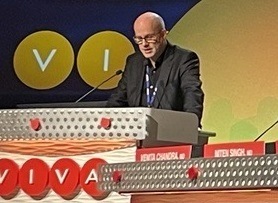
At the 2022 Vascular Interventional Advances (VIVA) meeting (Oct. 31–3 Nov. 3), Michael Lichtenberg, MD, from Arnsberg Clinic, Arnsberg, Germany, reported a subgroup analysis of the MIMICS-3D EU registry, revealing a headline finding of “excellent” three-year outcomes for the BioMimics 3D stent (Veryan Medical) in longer lesions.
The presenter noted that the MIMICS-3D EU registry forms part of the wider MIMICS clinical research program, which he said will enroll more than 1,750 patients worldwide. In the most recent findings, Lichtenberg noted that the BioMimics 3D stent showed impressive durability through three years of follow-up in the prospective, single-arm, multicenter MIMICS-3D EU registry in a challenging, ‘real-world’ patient population. At VIVA, Lichtenberg presented a post-hoc subgroup analysis which investigated the three-year performance of BioMimics 3D in patients with long and very long lesions.
According to Lichtenberg, the patients in the MIMICS-3D EU registry represent a more challenging population than typically enrolled in registry studies. Specifically, he detailed that 9% of patients had long lesions (140mm to ≤190mm), 24% had very long lesions (>190mm), 24% had chronic limb-threatening ischemia (CLTI), 53% had moderate-to-severe calcification, and 57% had chronic total occlusions (CTOs).
The MIMICS-3D EU registry enrolled 507 patients at 23 European sites, Lichtenberg noted. The long lesions and very long lesion cohort consisted of 165 patients (33%), 46 in the long lesion subgroup (mean lesion length of 160.2±22.6mm, 33% diabetes, 25% severe bilateral wall calcification, 58% occlusion) and 119 in the very long lesion subgroup (mean lesion length of 269±61mm, 40% diabetes, 38% severe bilateral wall calcification, 92% occlusion).
Lichtenberg informed VIVA attendees that the primary safety outcome of major adverse events (MAE) at 30 days was 100% for the long lesion subgroup and 97% for the very long lesion subgroup. He added that the primary efficacy endpoint demonstrated as Kaplan-Meier estimate for freedom from clinically driven target lesion revascularization (CD-TLR) was 85% at 12 and 78% at 36 months for the long lesion subgroup and 82% and 70% at 12 and 36 months respectively, for the very long lesion subgroup.
Furthermore, the presenter noted that the Kaplan-Meier estimate of primary patency was 85% and 75% at 12 and 36 months for long lesions and 78% and 61% at 12 and 36 months for very long lesions. Finally, he revealed that investigator-reported fractures through 36 months were low for both groups; 0% and 0.8% for the long lesion and very long lesion groups, respectively.











